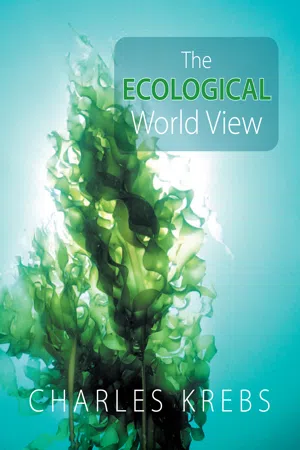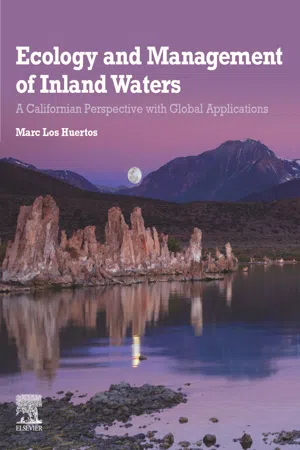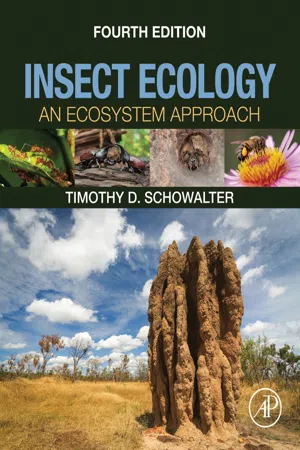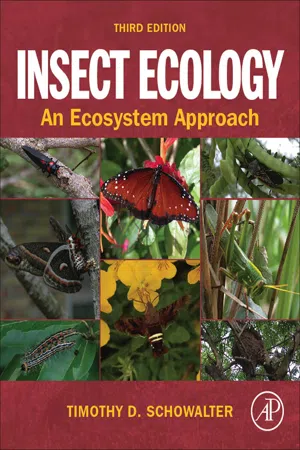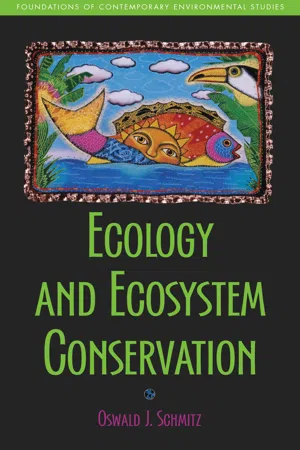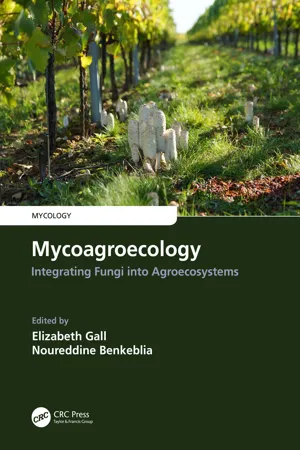Biological Sciences
Population Limiting Factors
Population limiting factors are environmental conditions or resources that restrict the growth of a population. These factors can include food availability, predation, disease, and competition for resources. They play a crucial role in regulating population size and can influence the distribution and abundance of species within an ecosystem.
Written by Perlego with AI-assistance
Related key terms
8 Key excerpts on "Population Limiting Factors"
- eBook - ePub
- Laurie Ann Callihan(Author)
- 2013(Publication Date)
- Research & Education Association(Publisher)
In general, most populations have an incredible ability to increase in numbers. A population without limiting factors could overpopulate the world in several generations. It is the limits existing within each ecosystem that keep this from happening.Limiting FactorsMany factors affect the life of an ecosystem, which may be permanent or temporary. Populations within an ecosystem will be affected by changes in the environment from abiotic factors (physical, non-living factors such as fire, pollution, sunlight, soil, light, precipitation, availability of oxygen, water conditions, and temperature) and biotic factors (biological factors, including availability of food, competition, predator-prey relationships, symbiosis, and overpopulation).These biotic and abiotic factors are known as limiting factors since they will determine how much a particular population within a community will be able to increase in number. For instance, the resource in shortest supply in an ecosystem may limit population growth. As an example, we know that photosynthetic organisms require phosphorous in order to thrive, so the population growth will be limited by the amount of phosphorous readily available in the environment. Conversely, growth may be limited by having more of a limiting factor (such as heat or water) than it can tolerate. For example, plants need carbon dioxide to grow; however, a large concentration of carbon dioxide in the atmosphere is toxic.Ecologists now commonly combine these two ideas to provide a more comprehensive understanding of how conditions limit growth of populations. It may be stated that the establishment and survival of a particular organism in an area is dependent upon both 1) the availability of necessary elements in at least the minimum quantity, and 2) the controlled supply of those elements to keep it within the limits of tolerance. - eBook - ePub
- Charles Krebs(Author)
- 2008(Publication Date)
- CSIRO PUBLISHING(Publisher)
Birth and death rates apply to populations, even though they are often stated as per individual. Individual plants and animals either live or die, but, averaged over a whole population, we can express these vital events as population averages to tell us how fast a population is growing or declining.The modern synthesis of population regulation has explored the practical issues involved in applying the two central principles illustrated in Figures 10.2 and 10.3 to real world populations. Let us start with a clear definition of two confusing terms:• limitation : a factor is defined to be a limiting factor if a change in the factor produces a change in average or equilibrium density. For example, a disease may be a limiting factor for a deer population if deer abundance is higher when the disease is absent.• regulation : a factor is defined to be a potential regulating factor if the percentage mortality caused by the factor increases with population density.1 For example, a disease may be a potential regulating factor only if it causes a higher proportion of losses as deer density goes up. Regulating factors must always be density-dependent.There is an important distinction between a potential regulating factor and an actual regulating factor. Unless the change in mortality is large enough, a regulating factor will not stop population growth. A spider that eats 1 of 1000 grasshoppers and 6 of 2000 grasshoppers is causing density-dependent mortality in the grasshopper population, but this impact is so tiny that it will not stop population growth.Figure 10.4 The modern view of population regulation processes. The population being studied is indicated by the blue circle. Extrinsic processes like predators and disease interact with the variable properties of individuals that make up the population (intrinsic processes), so that population regulation emerges as a result of interplay between these two kinds of processes: extrinsic and intrinsic. We cannot assume that extrinsic agents like diseases or predators act on individuals of different age or sex in the same way, so we must take into account the composition of the population when we study population regulation. - eBook - ePub
Ecology and Management of Inland Waters
A Californian Perspective with Global Applications
- Marc Los Huertos(Author)
- 2020(Publication Date)
- Elsevier(Publisher)
Whereas competition may influence population dynamics, exclude weaker competitors, and promote niche differentiation, we also recognize that numerous other types of species interactions occur in streams, lakes, wetlands, etc. Predation, cannibalism, disease, and parasitism are commonly observed factors that affect population dynamics.After reading this chapter, you should be able to- 1. Use predator–prey equations to evaluate the role of trophic interactions to predict population dynamics;
- 2. Summarize how sexual selection can influence population dynamics, e.g., predator/prey and infection vector and host;
- 3. Describe succession and how communities change with time;
- 4. Evaluate various lotic and lentic systems using energy transfer and nutrient flux in ecosystems.
Environment: Biotic Factors
Types of Species Interactions
Whereas the common use of the word “environment” refers to everything around us, ecologists identify two broad environmental factors: 1) abiotic factors: the physical and chemical factors, and 2) biotic factors: interacting organisms. When evaluating an area, we analyze a combination of abiotic and biotic factors to better understand the patterns and processes in ecological systems. The biotic factors include numerous types of interactions, including competition, discussed in Chapter 4 . Although inter- and intraspecific competition may play an important role in population growth, other asymmetric interactions also structure communities in visible and dramatic ways (Table 5.1 ).Table 5.1 Type of asymmetric interactions between two species.Interaction Effect of Sp. 1 on Sp. 2 Effect of Sp. 2 on Sp. 1 Exploitation Positive Negative Competition Negative Negative Mutualism Positive Positive Commensalism None Positive Amensalism None Negative Nuetralism None None Extending Population Biology
Primary Production and Herbivory
Periphyton is a combination of algae and bacteria that grow on stream bottom substrates. The growth of the algae is not only controlled by the competition for light and nutrients, but also by herbivory. Herbivory is a type of exploitation as it reduces algae (or plant) biomass, but have other effects too, e.g., increasing the diversity of the algae species, increasing productivity by reducing self-shading, and stimulating growth by releasing nutrients. But these changes can also depend on the herbivore species. - eBook - ePub
Insect Ecology
An Ecosystem Approach
- Timothy D. Schowalter(Author)
- 2016(Publication Date)
- Academic Press(Publisher)
K . Carrying capacity is not constant, but depends on factors that affect both the abundance and suitability of necessary resources, including the intensity of competition with other species that also use those particular resources.Density-independent factors modify population size, but only density-dependent factors can regulate population size, in the sense of stabilizing abundance near carrying capacity, through negative feedback processes. Regulation requires environmental feedback, such as through density-dependent mechanisms that allow population growth at low densities but reduce population growth at high densities (Isaev and Khlebopros, 1979 ). However, disturbances or environmental changes can change population size abruptly and either inhibit regulatory factors temporarily, and trigger population growth, or reduce population size and alleviate the induction of regulatory mechanisms (Schowalter, 2012 ).Nicholson (1933 , 1954a ,b , 1958 ) first postulated that density-dependent biotic interactions are the primary factors determining population size. Andrewartha and Birch (1954) challenged this view, suggesting that density-dependent processes generally are of minor importance in determining abundance. This debate was resolved with recognition that regulation of population size requires density-dependent processes, but abundance is determined by all factors that affect the population (Begon and Mortimer, 1981 ; Isaev and Khlebopros, 1979 ). However, debate continues over the relative importance of competition and predation, the so-called “bottom-up ” (or resource concentration ) and “top-down ” (or trophic cascade ) hypotheses, for regulating population sizes (see also Chapter 8 ).Bottom-up regulation is accomplished through the dependence of populations on resource supply. Suitable food is most often invoked as the limiting resource, but suitable shelter and oviposition sites also may become limiting as populations grow. Increased quality or availability of resources promotes population growth. As populations grow, resources become increasingly limited and objects of intense competition, reducing natality and increasing mortality and dispersal (Chapter 5 - eBook - ePub
Insect Ecology
An Ecosystem Approach
- Timothy D. Schowalter(Author)
- 2006(Publication Date)
- Academic Press(Publisher)
Factors affecting population size can operate over a range of time delays. For example, fire affects numbers immediately (no time lag) by killing exposed individuals, whereas predation requires some period of time (time lag) for predators to aggregate in an area of dense prey and to produce offspring. Hence, increased prey density is followed by increased predator density only after a given time lag. Similarly, as prey abundance decreases, predators disperse or cease reproduction, but again, only after a time lag.C. Regulatory Mechanisms
When population size exceeds the number of individuals that can be supported by existing resources, competition and other factors reduce this size until it reaches levels in balance with resource supply. This equilibrium population size, which can be sustained indefinitely by resource availability, is termed the carrying capacity of the environment and is designated as K. Carrying capacity is not constant, but depends on factors that affect both the abundance and suitability of necessary resources, including the intensity of competition with other species that also use those particular resources.Density-independent factors modify population size, but only density-dependent factors can regulate population size, in the sense of stabilizing abundance near carrying capacity. Regulation requires environmental feedback, such as via density-dependent mechanisms which reduce population growth at high densities but allow population growth at low densities (Isaev and Khlebopros 1979 ). Nicholson (1933 , 1954a , b , 1958 ) first postulated that density-dependent biotic interactions are the primary factors that determine population size. Andrewartha and Birch (1954) challenged this view, suggesting that density-dependent processes are generally of minor importance in determining abundance. This debate was resolved with the recognition that regulation of population size requires density-dependent processes, but abundance is determined by all factors that affect the population (Begon and Mortimer 1981 , Isaev and Khlebopros 1979 ). However, debate continues over the relative importances of competition and predation, the so-called “bottom–up” (or resource concentration) and “top–down” (or trophic cascade) hypotheses, for regulating population sizes (see also Chapter 8 - eBook - ePub
- Oswald J. Schmitz(Author)
- 2013(Publication Date)
- Island Press(Publisher)
extrinsic limiting factors because they are embedded in food webs in which they must compete with individuals of other species for resources or space. Moreover, they also may be subject to predation.We can deduce the effect of competitors and predators on a focal species population using the fitness principles underlying figure 4.2a . In essence, individuals of a competitor species can have the same qualitative effect on individuals within a focal species population as individuals of the same species have on each other. That is, by vying for resources or space with members of another species, the per capita share of resources again declines. This decline in resource share causes an overall decline in per capita birth rates and increase in per capita mortality rates of the focal species (figure 4.2b ).The consequence is that the focal species population may reach a new balance (Bc ) between birth and mortality rates that depends on the density of the competitor species (the extrinsic factor). The population density at this new equilibrium will be less than that in the absence of the competitor species (figure 4.2b ).That is, the competitor species (external factor) limits the focal species population below its carrying capacity.Predators affect focal populations differently than competitor species. Predators can scare prey, which causes prey to spend less time feeding because they must be vigilant. This in turn reduces resource intake, which can lower birth rates and increase mortality rates across all prey densities. This would have the same qualitative net effect on per capita birth and mortality rates as competition and thus reduce the focal species below its carrying capacity (figure 4.2b ). Predators also increase mortality of their prey by hunting and capturing them. The new equilibrium density of the focal species will fall below that in the absence of predators. The exact level at which the new balance is achieved will depend on whether predators are inefficient (P1 ) or highly efficient (P2 ) at capturing their prey. (See figure 4.2c - eBook - ePub
Understanding Nature
Ecology for a New Generation
- Louise M. Weber(Author)
- 2023(Publication Date)
- CRC Press(Publisher)
Anderson et al. 1955 ).Lakes have herbivores like the crustacean Daphnia that eat the phytoplankton. Use the idea of diminishing returns as part of your hypothesis for explaining how phytoplankton can recover from frequent steep declines in abundance.In the Equilibrium Debate, Who Was Right?
Population growth curves from real species do not confirm the contention of equilibrists that populations stabilize around an equilibrium. At best, populations are weakly regulated (Ziebarth and Abbott 2010 ). Most non-microbe species have abundances with a range of variability, and growth tends to be boom and busty. The more interesting question is, what causes the variability? Beyond abiotic factors like weather, biotic factors like the Allee effect, stunting, and self-thinning account for some of the deviations from the logistic.There were other factors to discover beginning in the 1960s. One technique called key factor analysis was used to determine the greatest cause of death within each age group of a population (Begon et al. 1996 ). Using life tables, individuals in the population had to be laboriously tracked until death. For example, in a population of Colorado Potato Beetle (Begon et al. 1996 , Harcourt 1971 ), the percentage of eggs that washed into a puddle during a hard rain was compared to the percentage of larvae preyed upon. These were compared to the percentage of adults that dispersed during migration and compared to the percentage that died during hibernation in an early frost.The conclusion from many studies was that a complex combination of biotic and abiotic factors contributes to mortality overall in populations. Neither biotic nor abiotic factors are universally more prevalent. The highest source of mortality might change from year to year even for a single species or population (Begon et al. 1996 - eBook - ePub
Mycoagroecology
Integrating Fungi into Agroecosystems
- Elizabeth Gall, Noureddine Benkeblia, Elizabeth Gall, Noureddine Benkeblia(Authors)
- 2022(Publication Date)
- CRC Press(Publisher)
5 Limiting Factors in Agriculture Noureddine BenkebliaDOI: 10.1201/9780429320415-5Contents
- 5.1 Introduction
- 5.2 Meteorological Limiting Factors
- 5.2.1 Extreme Temperature as a Limiting Factor
- 5.2.2 CO2 Concentration as a Limiting Factor
- 5.3 Where Meteorological and Land Factors Meet: Water as a Limiting Factor
- 5.4 Limiting Land Factors: Nutrient Supply
- 5.4.1 Nitrogen (N)
- 5.4.2 Phosphorus (P)
- 5.4.3 Potassium (K)
- References
5.1 Introduction
Agricultural history has paralleled humankind’s technological and social development, and archaeological evidence indicates that food and animal domestication first occurred at least 10,000 years ago. However, according to the FAO (2017) , agriculture is at present one of the riskiest and one of the most vulnerable activities of the modern day due to its negative impact on the environment (greenhouse gases, fertilizer pollution, etc.) and climate change threatening food production (Rosenzweig et al. 2013 ). Land use and crop production can be affected by many constraints and limitations, which fall into four categories: (1) meteorological factors, including global climate, CO2 concentration, and the effects of local weather and precipitation; (2) land factors, including nutrient and water availability and soil-weather interactions; (3) biological factors, including pests and diseases; and (4) human factors, like social preferences or economics. Of these four types of constraints, this chapter will discuss in detail meteorological (temperature, CO2 concentration, and water) and land factors (water and soil nutrient availability), since historically these are the most limiting factors affecting agriculture and have fewer or no mitigation potentials compared with biological (Chapters 6 , 7 , and 12 –16 ) and human (Chapters 8 –10 ) factors (Schlenker et al. 2007 ; Tanaka et al. 2006
Index pages curate the most relevant extracts from our library of academic textbooks. They’ve been created using an in-house natural language model (NLM), each adding context and meaning to key research topics.

